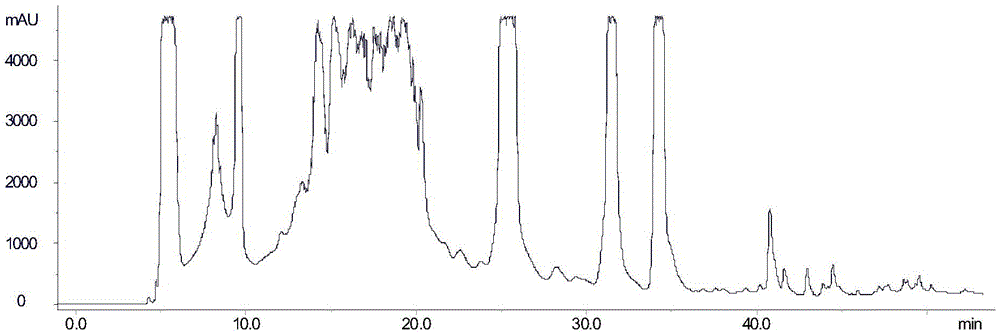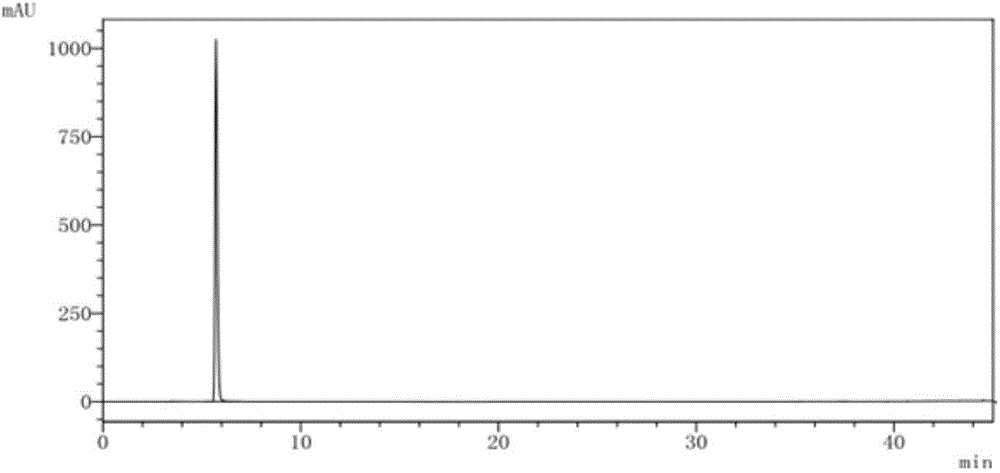Method for separating three tannin monomer components from garden burnet
A technology of monomer components and Burnet, which is applied in the field of high-performance liquid chromatography separation, can solve the problems of low yield, time-consuming, easy residue of mobile phase, etc., and achieve fast separation speed, high separation efficiency and good industrial prospects Effect
- Summary
- Abstract
- Description
- Claims
- Application Information
AI Technical Summary
Problems solved by technology
Method used
Image
Examples
Embodiment 1
[0043] Embodiment 1 Separation and purification method of the present invention
[0044] (1) Pretreatment of raw materials
[0045] A certain amount of crude extract of Burnet burnet was weighed, dissolved in 80% methanol aqueous solution, ultrasonicated for 5 minutes, filtered with a 0.22 μm filter membrane, and set aside.
[0046] Burnet crude extract can be a mixture of a group of tannin compounds extracted from the dried rhizome of Burnet by using the prior art.
[0047]The solvent has a great influence on the separation and stability of the sample. Since the sample has a certain fat solubility and at the same time needs to take into account the hydrophilic compounds, the crude extract of Burnet burnet is stable and has good solubility in methanol aqueous solution. The resolution is also good during analysis, so 80% methanol is selected as the solvent.
[0048] (2) Preparative HPLC separation of three monomer components in Burnet Burnet crude extract
[0049] Take the B...
Embodiment 2
[0063] Embodiment 2: determination of mobile phase
[0064] Several mobile phases with different compositions were selected to separate various monomer components contained in the Burnet extract, among which the mobile phase composed of acetonitrile-hydrochloric acid (pH3. It can achieve good separation of various components, but considering the high price of acetonitrile, we chose relatively economical methanol as the mobile phase under the condition of the same separation effect. Therefore, methanol-hydrochloric acid (pH3.0) aqueous solution was finally selected as the mobile phase system when preparing samples, and in order to obtain better resolution, the mobile phase composed of methanol-phosphoric acid (0.1%) aqueous solution was selected as the mobile phase when detecting samples. Mutually.
[0065] The influence of the pH value of the mobile phase on the separation and stability of each component was investigated. According to the chemical composition characteristics ...
Embodiment 3
[0068] Embodiment 3: Analytical high performance liquid chromatography detects and separates three kinds of monomer components obtained
[0069] When the three components obtained in Example 1 were detected, its liquid chromatography conditions were specifically: chromatographic column: Inertsil, ODS (C 18 ), 5μm, 250mm×4.6mmm ID. Flow rate: 1.0ml / min; Column temperature: 40°C; Detection wavelength: 254nm; Injection volume: 60μl. Mobile phase A: 0.1% phosphoric acid solution; mobile phase B: methanol. The mobile phase gradient is shown in Table 3.
[0070] Table 3 Mobile phase gradient
[0071] time (min)
[0072] See the liquid chromatogram Figure 3-5 , image 3 is the liquid chromatogram of gallic acid components, Figure 4 It is the liquid chromatogram of 3,3′,4′-O-trimethyl retrogallate-4-O-β-D-xyloside component, Figure 5 It is a liquid chromatogram of 3,3',4'-O-trimethyl retrogallic acid components.
PUM
| Property | Measurement | Unit |
|---|---|---|
| Wavelength | aaaaa | aaaaa |
| Particle size | aaaaa | aaaaa |
Abstract
Description
Claims
Application Information
 Login to View More
Login to View More - R&D
- Intellectual Property
- Life Sciences
- Materials
- Tech Scout
- Unparalleled Data Quality
- Higher Quality Content
- 60% Fewer Hallucinations
Browse by: Latest US Patents, China's latest patents, Technical Efficacy Thesaurus, Application Domain, Technology Topic, Popular Technical Reports.
© 2025 PatSnap. All rights reserved.Legal|Privacy policy|Modern Slavery Act Transparency Statement|Sitemap|About US| Contact US: help@patsnap.com



